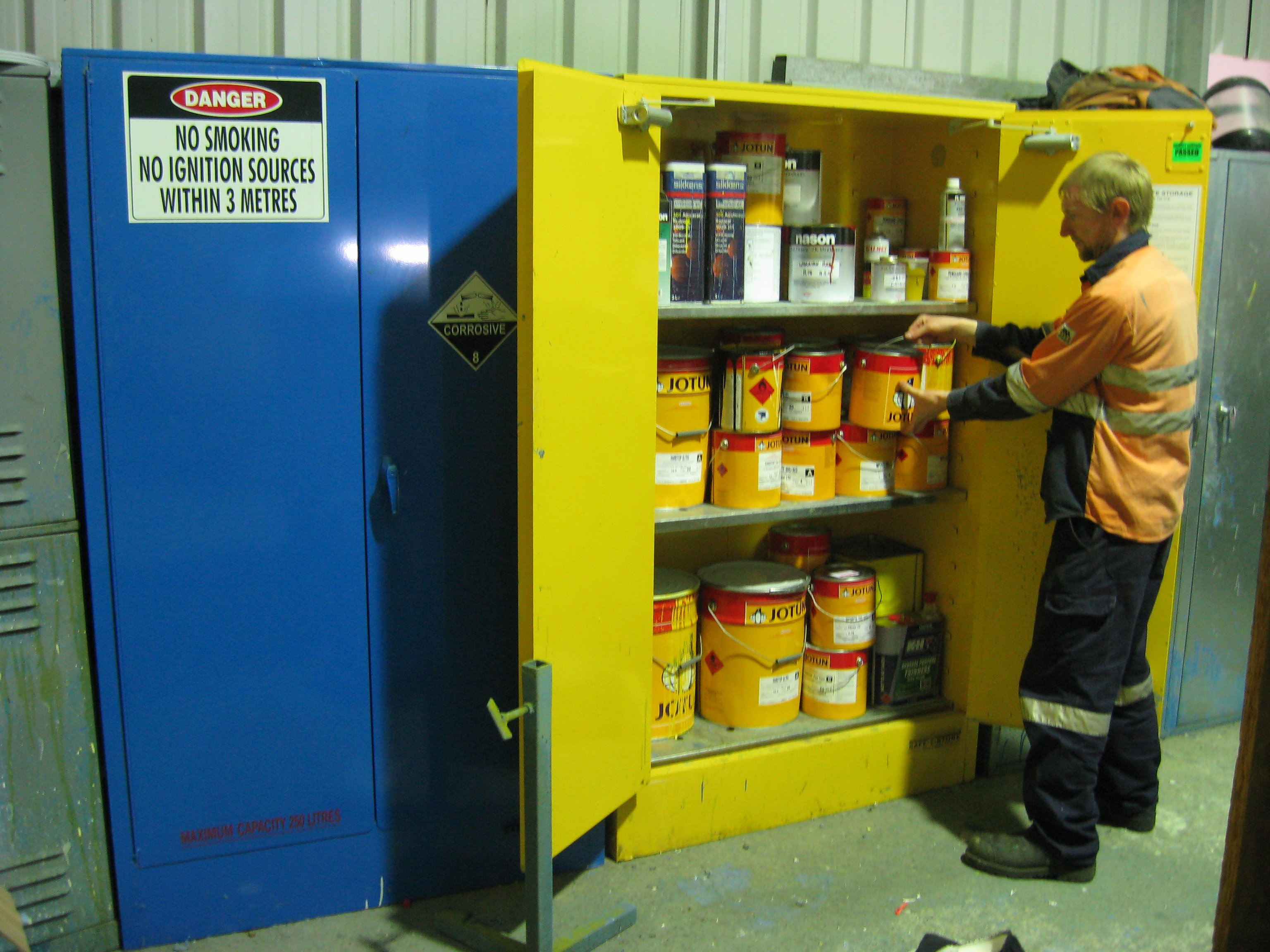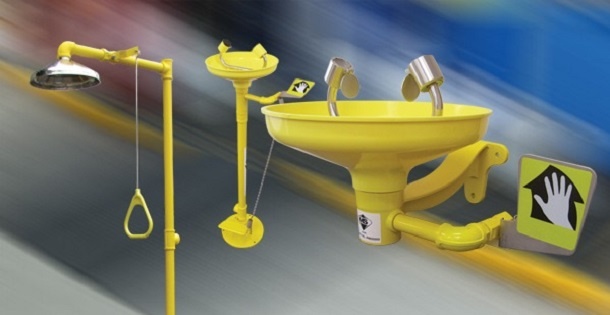With a team of Field Auditors who have visited countless workplaces across the country, you can imagine that we’ve seen quite a few unusual practices when it comes to the handling and storage of Dangerous Goods. However, one reoccurring issue that we spot (more than we’d like to) is when organisations fail to store Class 3 Flammable Liquids correctly. It could be unstable piles of chemicals placed on the floor of a warehouse or drums sitting on the ground without bunding. We’ve also seen these unsafe practices happen in close proximity to a compliant flammable liquids storage cabinet — which, to make matters worse, has been stocked with combustible items such as toilet paper or brooms!
5-Steps Towards Flammable Liquids Safety
To make the handling and storage of flammable liquids a simpler, easier to understand the process, we’ll be detailing a clear cut 5-step process so you can ensure your staff and supervisors can work safely with your stores of flammable liquids (and other Dangerous Goods that you may be carrying).
We’ll be detailing recommendations for the following 5 steps towards flammable liquids safety in the workplace:
Step 1 Formal Inductions
Step 2 Understanding Responsibilities
Step 3 Clear Operating Procedures
Step 4 Sufficient Supervision
Step 5 Safety Procedures and Housekeeping
By following this process, you’ll be able to educate your staff about the safe handling and storage practices for flammable liquids. This will actively reduce your risk of fire, explosion, human harm and environmental damage.
1. Create A Formal Induction Program
When your job site carries any type of Dangerous Goods you absolutely need a formal induction program that provides safety information to new workers and other people who access the site. The most effective inductions focus on essential information that is relevant to the job (or task) the worker or contractor will be conducting onsite.
IMPORTANT: To create an effective induction and/or staff training program, you must engage and interest your staff. Avoid long-winded and boring inductions, as staff will lose interest in the subject matter – regardless of how important it is. You don’t want your induction to become a mere formality that has very little impact on the safety of your staff and organisation.
Your induction should contain:
- Location of chemicals and other Dangerous Goods at the job site. Eg, issue a site map and point out chemical stores during a pre-shift walk around.
- Site rules and restricted access areas. Eg, speed limits for site vehicles and loading access areas. No personal electronics in flammable liquids stores.
- Emergency information. Eg, location of emergency exits, firefighting equipment, safety showers, eyewash stations, chemical spill kits.
- Equipment and PPE. Eg, mandatory PPE when handling chemicals.

Developing an engaging formal induction for your staff is a key factor in maintaining chemical safety.
Inductions can be delivered in a variety of ways, but we find the most effective to be a mix of face-to-face sessions that includes a detailed site tour. We also strongly suggest following up this induction with a digital presentation that reinforces the key issues raised in the induction.
IMPORTANT: Ensure all your workers and contractors review their inductions at regular intervals. Online inductions are an excellent way of supporting the main program and facilitating reviews.
2. Ensure Everyone Understands Their Responsibilities
Every worker and contractor onsite must understand their contribution to workplace safety and their individual responsibilities. This isn’t just a recommendation, it’s part of every organisation’s safety responsibility under WHS Regulations.
The responsibilities of your staff may include the following points:
- Obeying site rules, complying with operational policy and safe work procedures.
- Following reasonable instructions from supervisors. This includes chemical handling, housekeeping and chemical storage practices.
- Knowing how to put on, take off, maintain and store PPE and other safety equipment correctly.
- Behaving in a way that does not endanger or compromise the safety of other workers (or themselves).
%20for%20flammable%20liquids.jpg?width=2200&name=Personal%20Protective%20Equipment%20(PPE)%20for%20flammable%20liquids.jpg) Responsibilities of individual staff members may include obeying all site rules, following instructions, wearing and maintaining PPE properly and behaving in a safe manner.
Responsibilities of individual staff members may include obeying all site rules, following instructions, wearing and maintaining PPE properly and behaving in a safe manner.
3. Have Clear Operating Procedures
Operating procedures are an essential step-by-step instruction manual to assist staff in carrying out their routine operations. However, many organisations make the mistake of developing a safe work procedure, only to issue it to workers and supervisors via email or a bulletin board.
Operating procedures are essential for efficiency, professionalism and safety. And when it comes to organisations that carry Class 3 Flammable Liquids, these operating procedures act as a vital safety measure that reduces risk to staff, property, the environment and even the wider community.
Operating procedures are effective when they are:
- Developed in consultation with the workers most affected. Eg, asking workers (who actually transfer fuel from drums to portable containers) for their ideas on a safe decanting policy.
- Clearly documented and accessible to workers at all times. Eg, available on the organisation’s intranet which all workers use and access regularly.
- Explained to workers. Eg, the policy is introduced and reinforced at a series of one-on-one and small group training sessions.
- Followed by managers and supervisors. Eg, managers, directors and the CEO of the company all abide by site speed limits and chemical access restrictions.
- Enforced by supervisors. Eg, supervisors respond quickly to non-compliance with safety procedures and follow up with training and counselling sessions.
 Effective operating procedures should be developed with the workers who are most affected by these procedures.
Effective operating procedures should be developed with the workers who are most affected by these procedures.
4. Provide Sufficient Supervision
Once your workers and contractors are properly informed about their responsibilities and set procedures and they know what is expected of them, you need to provide proper supervision.
Supervision isn’t about catching people out when they are doing the wrong thing (though it is part of the role) — it’s about having someone in charge that help maintain safety and work procedures.
When providing supervision for staff handling flammable liquids, we recommend that you:
- Observe workers carrying out their duties. Eg, are workers loading the flammable liquids cabinets correctly?
- Provide training and assistance when required. Eg, conducting extra training with a new worker at the fuel decanting station.
- Being on hand when workers are sick or injured. Eg, ensuring an injured worker receives medical attention and completes the required notification documents.
- Organise repairs. Eg, arranges the replacement of a leaking chemical container.
- Solve problems. Eg, changes chemical purchasing and delivery schedules to address the issue of chemical cabinets being overloaded.
- Take corrective action. Eg, replaces missing warning placards on the flammable liquid’s cabinet.

Supervising the handling and storage of Dangerous Goods is an important part of ensuring flammable liquids safety.
5. Enforce Safety Procedures and Housekeeping
Finally, step 5 of our process focuses on ensuring that your managers and supervisors enforce both the safety procedures and good housekeeping procedures for areas that carry flammable liquids.
Policy enforcement is about having auditing and review systems in place, rather than arbitrarily calling out employees.
To maintain high standards of safety and housekeeping procedures, we strongly suggest:
- Daily Inspections. Inspecting the state of work areas, chemical stores, decanting stations and emergency equipment. Ensure things are put away and being used correctly.
- Safety audits. Engaging safety professionals to audit the worksite, review known chemical hazards and assess control measures.
- Scheduled maintenance. Carrying out integrity testing and maintenance to ensure that safety equipment, PPE, safety cabinets, safety showers, eyewash units, first aid equipment and operational machinery — are all fully operational and structurally sound.
 As part of your safety and housekeeping procedures, you should make sure that scheduled maintenance is performed on equipment including emergency decontamination equipment.
As part of your safety and housekeeping procedures, you should make sure that scheduled maintenance is performed on equipment including emergency decontamination equipment.
Having an auditing and inspection system in place is the first step. You also need a course of remedial and corrective actions.
Some remedial and corrective actions that you can apply to your workplace may include:
- Taking immediate action. If something is deemed an unsafe work practice, immediate action must be taken. For example, you may have to request that workers tidy up a messy area and put away chemicals before they create a serious fire or explosion hazard.
- Investigating repeat occurrences. Find out why policies aren’t being followed. Perhaps the flammable liquids cabinet is full or broken, or there may be another issue that is not allowing staff to conduct themselves in a safe and methodical manner.
- Training workers. Conducting remedial training with workers who aren’t sure of their job roles is an important part of the flammable liquids training process.
- Counselling employees. Reminding workers of their individual responsibilities to follow procedures and work safely.
- Terminating employment or work contracts. We aren’t suggesting you get heavy-handed, but after a number of repeat offences (when workers have been continually counselled and retrained), sometimes your only option is to terminate the services of a worker who refuses to comply with safe work procedures. This is not only to reduce the risk to your organisation, it’s to prevent a terrible accident from happening to the worker or their team.
Handling and Storing Flammable Liquids Safely
With our 5-step process now explained, we hope you’ll feel more confident in developing a training program for your staff, supervisors and contractors who are handling Class 3 Flammable Liquids at your site. If you’d like to learn more about taking the next step in achieving and maintaining flammable liquids safety and compliance, we have an eBook that can help. Essential Considerations When Storing Flammable Liquids Indoors is written in a clear and concise manner, but it’s full of essential information about the safe storage of flammable liquids. Whether you’re conducting a risk assessment, or you’re revising your staff training programs, why not take advantage of our free guide and access your copy today?
Joining the team as a Dangerous Goods Storage Consultant, Melissa Hampton became Storemasta's Marketing Manager in late 2021. With extensive knowledge and experience in chemical compliance, Melissa is responsible for leading the Marketing team and helping shape their marketing strategy. In her spare time, you can find Melissa hiking, swimming and enjoying the great outdoors in beautiful north-west Tasmania.
